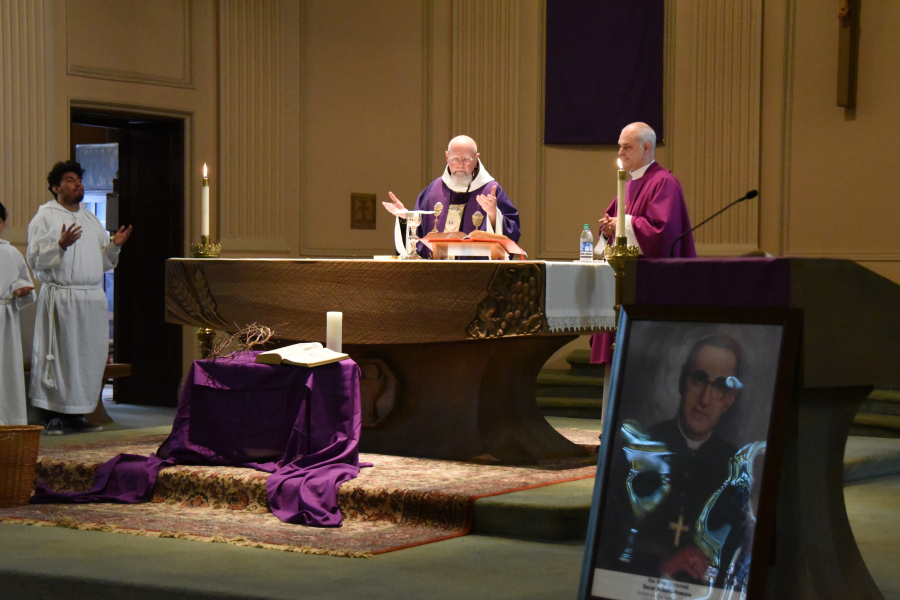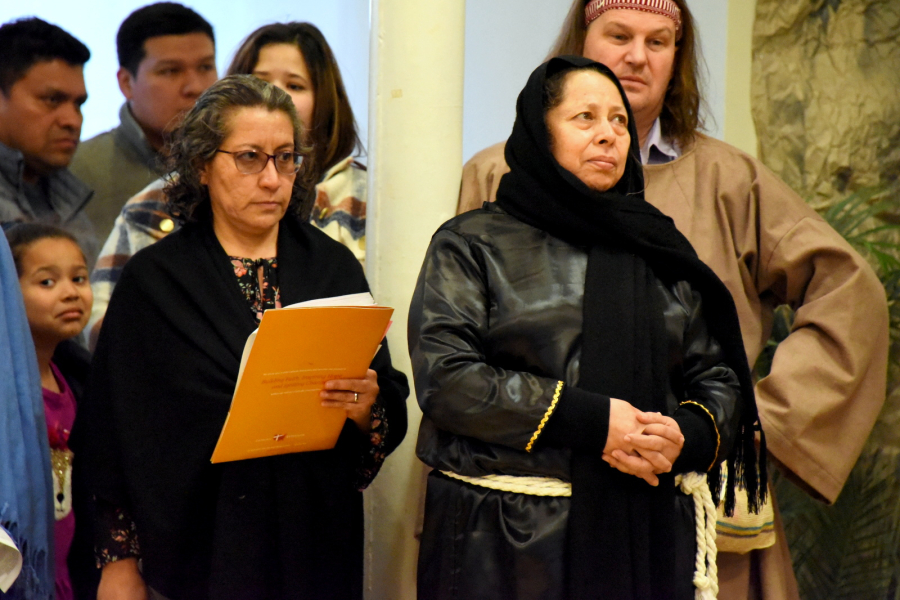Sisters offer the ministry of presence to the Hispanic community

Whether teaching faith formation, leading Stations of the Cross, or singing and playing the guitar, you will find Sister Elsa Telon, RSR, and Sister Mirian Maradiaga, RSR, actively engaged with members of the Hispanic community in Maine.
“They have been really a magnificent addition to us, especially with the teaching of the children to prepare them for the sacraments,” says Father Michael Sevigny, OFM Cap., director of Hispanic Ministry for the Diocese of Portland. “I think their being religious sisters, too, brings a great blessing.”
Sister Elsa and Sister Mirian are members of the Sisters of Our Lady of the Holy Rosary, and since 2015, they have been part of the Hispanic ministry team in Maine, serving alongside Father Sevigny and outreach coordinators José Perez López and Rosario Starratt.
“It’s connecting with the people that I see here and visiting the people,” says Sister Mirian.
“To be here, just to be a presence, I think, is something nice,” says Sister Elsa.
Both sisters are originally from Central America. Sister Elsa grew up in Guatemala, and Sister Mirian is from Honduras. Founded in Rimouski, Canada, the Sisters of Our Lady of the Holy Rosary have been present in Honduras since 1964 and in Guatemala since 1984.
Sister Elsa and Sister Mirian are involved in many aspects of Hispanic Ministry in the diocese but are primarily dedicated to faith formation for both adults and children. While the sisters’ service is centered in Portland, where there is the greatest concentration of Spanish-speaking residents in Maine, they and other members of the Hispanic ministry team also travel to other parts of the state to serve the growing Hispanic community.
“It’s different in different places, but we have a program for each community where we go,” says Sister Elsa.
In addition to Portland, Masses in Spanish are now offered in Augusta, Brewer, Cherryfield, Lewiston, Pittsfield, Sanford, and, on occasion, in Skowhegan.
“I started some ministry in Skowhegan in a hotel, and the sisters are always with me and getting ready to play music, adding so much to the liturgy and guiding the people and teaching them,” says Father Sevigny. “It’s been a wonderful blessing for the ministry.
Father Sevigny says before Masses, there is often an hour of Lectio Divina, during which they join in reading and reflecting on Scripture.
“It’s basically trying to get from the people their thoughts about Scripture and things. It’s a moment of great teaching,” he says.
The Hispanic Ministry team has also begun offering retreats, including one held at the end of March at St. Michael the Archangel Church in Cherryfield.
“It gives us time to be able to give a teaching, share with them, and it also gives us an opportunity for us to get to know who the people are and for them to get to know us,” says Father Sevigny. “I’m trying to be more present, especially in places that are far off, like Cherryfield.”
The sprawling nature of Maine’s Hispanic community is just one of the difficulties facing the Hispanic Ministry team. Although some members of the community have made Maine their home, there is also a large migrant population, for instance, those who come to work in the blueberry fields of Washington County.
“You can’t have a regular faith formation process because they are here, and then they go,” says Sister Elsa.
Another challenge is the work schedules of the people. Many are employed in the hospitality industry or work on farms, meaning weekend and night shifts are common.
“One of the challenges to doing faith formation on Sundays is that so many of them are working, and they have to leave because they have work hours,” says Sister Mirian. “They will work on Sundays, and none of them get the same days off, so it’s a real challenge.”
“It’s hard because of their schedules, but we try to do something with them. We try to visit them,” says Sister Elsa.
The sisters emphasize the importance of the ministry of presence because they say the people often feel isolated due to the language barrier and due to a fear of authorities, which makes them hesitant to join in community activities. By visiting with them, the sisters can help ease some of their concerns and help them to remember that they are not alone.
“As they continue doing the things they are doing — working to look for a better life — God is with them. It’s not that they moved, and God is back in Guatemala, Honduras, El Salvador, or Ecuador. God is with them here,” says Sister Elsa. “People work very hard, constantly, so when they are with us, it’s a time for them to pause and to be with God,” says Sister Mirian. “It’s important because we can give them the Christian and human values.”
The sisters say although it’s hard to connect with everyone, they have formed strong ties with some of the families they serve.
“They invite us to go to the first Communion, the baptism, the birthday for their kids,” says Sister Elsa. “When someone in their family dies in their country, we go to pray the novena with them in their homes, and we are part of their lives, like they are for us. This is something that, for me, I am so happy about because to be part of those families’ lives, they are my family, too.”
Sister Elsa remembers going to a boy’s school concert and seeing the teacher’s surprise when they showed up because he had told her he had invited family members and a couple friends.
“She thought that his friends were other little kids like him, but the friends were us,” she says, laughing.
Sister Elsa says the closeness of the community is something Latinos are accustomed to in their home countries and something they miss when they come here.
“We go through the streets, and everybody says hi. We know each other,” she says, remembering her hometown of San José El Rinconcito. “Everybody has a friendship.”
The Catholic church, Sister Elsa says, was at the heart of the town where she was raised. Not only did she attend Mass every Sunday, but catechism classes were held every weekday afternoon, signaled by the ringing of the church bell.
“The different sounds of the rings of the bell tell you whether it’s the Mass, the catechism, or the Rosary,” she says. “Everyone could hear the bell.”
Sister Elsa says her grandfather served as sacristan, and her entire family was active in the church.
“It was something that was part of your life,” she says.
She says she first thought about a religious vocation after meeting a sister when she was a child, but at the time, there weren’t many sisters present in her community, and the people thought of them as distant rather than warm. Then, after moving to Guatemala City to study, she met Sister Mirian and other members of the Sisters of Our Lady of the Holy Rosary while participating in a young adult group.
“The sisters came every time to visit and just to be with us, and it was something that touched my heart,” she says. “They were very happy, so that caught my attention because of the joy and closeness of them.”
Sister Elsa says she thought, perhaps, she was called to join them. Already in her mid-20s, she says she went on a retreat to ponder her vocation.
“I felt that it was my time to decide what to do with my life,” she says. “I needed to say yes or no to Jesus.”
She says the death of her cousin, a close friend, in an accident, led her to reflect on her life.
“It was something that helped me to decide at that moment because I thought that if God called me home at this time, He would ask me, ‘What did you do in your life? Looking behind, what did you do and what are you doing now?’” she says.
She decided to enter the sisters’ novitiate in Honduras and soon became convinced that it was where she belonged.
“I was sure it was my vocation, the call of God. I was sure of that because I was happy there,” she says. “Even though you spent your whole life serving the church, it’s a different life, a different style of life, but I was happy, and I really knew at that time that it was something I wanted.”
While Sister Elsa grew up surrounded by Catholicism, Sister Mirian says her family was not involved with the Church. She says her faith life developed through participation in youth groups and retreats. She says she used to tuck away some of the money her parents gave her for school, so she could attend retreats, making sure all her household chores were done, so she would be allowed to go.
“I went because I wanted to know what God wanted of me,” she says.
Sister Mirian says her parents were against her joining the Sisters of Our Lady of the Holy Rosary, but that is where she felt called.
“It was the joy that they had and also their commitment to the people,” she says. “They were happy and content and close to the people.”
At age 19, after graduation, she left to join them.
“I just packed my suitcases, and I decided that I was going to go,” she says.
She uses one word to describe what she found with the sisters: “Happiness.”
Sister Mirian’s ministry has included working in youth ministry and helping to form leaders in Honduras; guiding aspirants, postulants, and young religious in her congregation; working in youth ministry and training catechists in Nicaragua; and helping to form leaders and teach the catechism in Guatemala. She also studied at the Institute of Integral Human Formation in Montreal, Quebec, and accompanied a group of young people there.
Although Sister Mirian says it wasn’t her original thought to come to Maine, she agreed because “my heart was without borders.”
Sister Elsa says she first learned there were sisters from their congregation in Maine when she was in novitiate. Because she has family members in the United States, she also had an awareness of the challenges that immigrants face when they arrive in a new country, and she wanted to help.
“I was thinking, what am I doing for them because it is our people,” she says. “I consider that I give my life to God through the people, to be with them, so it was something I needed to do.”
She was given permission to go to Maine for a year and a half, so she could get a feel for what it would be like. but meeting the people and seeing the need led to her desire to return.
“It was a beautiful experience to be with them,” she says. “I love to be with people.”
The sisters say that they hope that through their presence here, they can help members of the Hispanic community continue to grow in closeness to God and to the Church.
“New people come, and they need to integrate, so we’re here to listen to them so that they can serve the Church and feel like they are family,” says Sister Mirian.
“To be close with them, to listen to them, to talk with them — all of those things that I saw in the sisters who helped me, I need to teach them, too,” says Sister Elsa. “We have to show Jesus to them.”
Father Sevigny says the work of the Hispanic ministry team, which is supported by the annual Catholic Appeal, is reaping benefits.
“The number of people attending different areas where we are saying Mass and doing retreat work, that is really growing,” he says. “It’s a positive note.”












